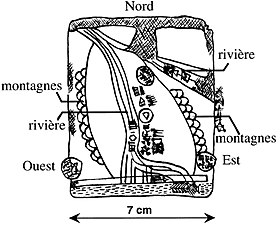Nuzi
Nuzi (or Nuzu; Akkadian: Gasur; today, Yorghan Tepe) was a city of Mesopotamia located southwest of Kirkuk in present-day Iraq, near the Tigris River.
History
Early Years
The first mentions of this city are found in cuneiform texts from Mesopotamia, corresponding to the Akkadian period. In these inscriptions, it is mentioned as Gasur (Ga Sur).
Hurrian-mitanium domain
In 1500 B.C. C., was occupied by the Hurrians, who gave the city the name Nuzu, from which the term Nuzi derives. From the 15th century B.C. C., and until 1350 a. C. approximately, it passed to the domain of the Hurrian kingdom of Mitani, constituting the extreme eastern point and southeastern limit of the kingdom.
Assyrian domination
Circa 1365 B.C. C., with the beginning of the reign of Ashur-uballit I, Assyria sees the beginning of the so-called Mesoasyrian expansion, which begins when it frees itself from the domination of its neighbors, the mitanians. After the fall of the Mitanite Empire before the forces of the Assyrian army, Nuzi, passes to the domain of Assyria.
Archaeological history
The site consists of a medium-sized multi-period tell and two small single-period mounds.
Excavations carried out in 1920 unearthed not only the city, but also thousands of tablets written in cuneiform. There are about 5,000 tablets, many of them of a legal and commercial nature, and approximately a quarter refer to commercial transactions of a single family. The vast majority of these finds are from the Hurrian period during the 2nd millennium BC. C. and the rest dates back to the founding of the city during the Akkadian Empire. A contemporary archive to the Hurrian archive at Nuzi has been excavated in the 'Green Palace' at the Tell al-Fajar site, 35 kilometers southwest of Nuzi.
This gave researchers invaluable light on the legal, commercial, and military activities of the city. It also helped to understand the culture of the Ancient Near East, including primitive versions of the stories of Biblical characters such as Laban or Jacob.
Multiple objects from the Late Bronze Age were found and a common type of pottery was identified for the first time in northern Mesopotamia during the period of the Mitanni kingdom, the so-called “Nuzi pottery”, characterized by painted decoration in white on a dark background. The motifs are usually geometric (triangles, bands), curvilinear (rosettes, scrolls) or floral. Objects have also been found that show the development of the glaze-enamel technique, marking the beginning of the production of glass objects: enameled bricks, frits, 'faience' (of colored glass). And other objects such as metal weapons, terracotta statuettes and representations of buildings.
Perhaps the most famous object found so far is the Nuzi map, considered the oldest known discovered map.


